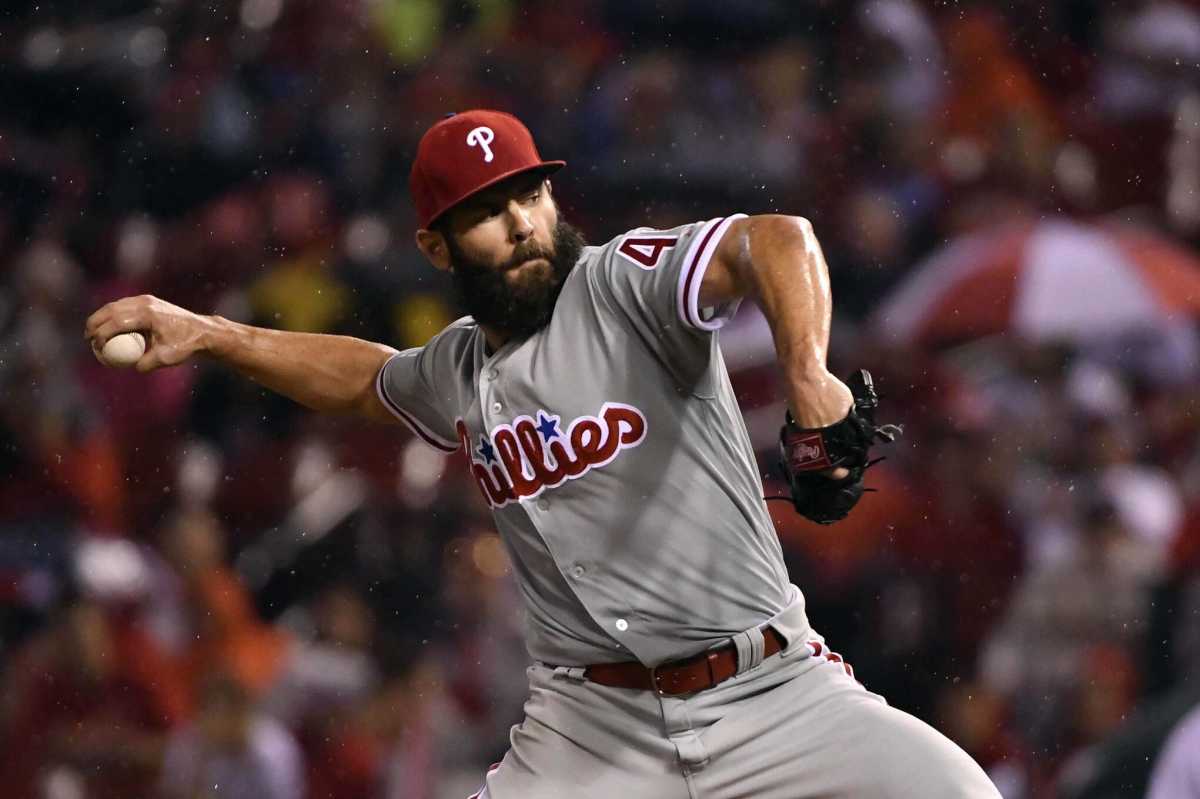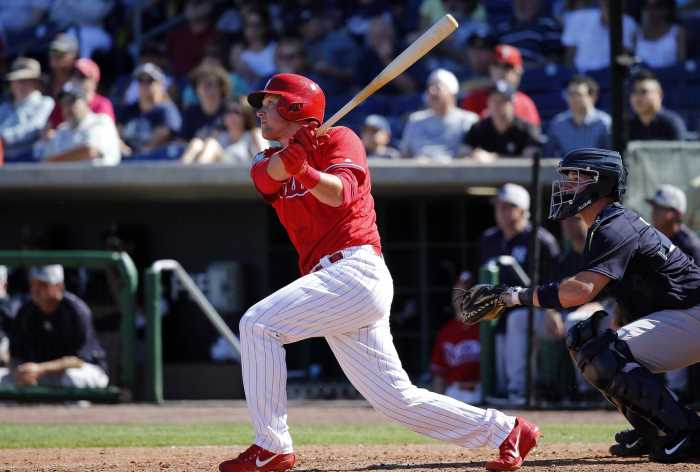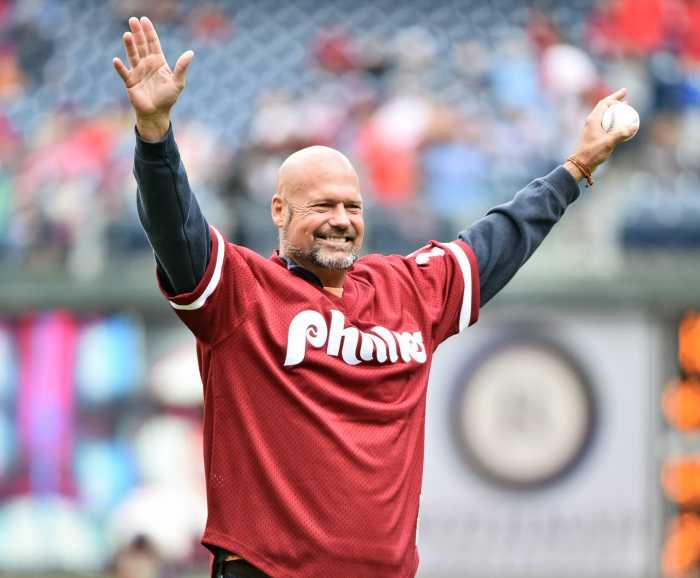On May 17, 2017, exactly one year ago to the date, the Phillies fell to the Texas Rangers 9-3. Zach Eflin was tagged for 11 hits and seven earned runs over four innings as the Phillies dropped their third straight and were in the midst of a 2-12 stretch. That particular May loss dropped the team to nine games under, 14-23.
Flash forward 365 days, and the current rendition of the Phillies defeated the Cardinals in St. Louis, no small task no matter the Cardinals’ talent, to take game one of a four game weekend series. The victory was the team’s 25th of the season, propelling them to nine games over .500 for the first time in years. It would take the former version of the Phillies another month and a half to reach the 25 win plateau, which, by that point on June 27, the team had already dropped 51 games.
What a difference a year makes. But what really has been the difference? The team is certainly scoring more runs, yes. And they’re also pitching markedly better. But, really, truly, what is the cause for the uptick in wins? For me, it boils down to three things in particular.
1. Rick Kranitz Has Improved His Pitching Staff
The Phillies’ pitching staff was lackluster under Bob McClure. That statement is no secret. But what Rick Kranitz has been able to do with his pitching staff through the first 41 games has been transcendent. And it begins at the top. Aaron Nola, who was on his way to establishing himself as a solid rotational arm has become the formidable ace the Phillies envisioned he would be when the drafted him with the seventh pick in the 2014 Draft. In nine starts, Nola has thrown 59.2 innings, posting a 1.99 ERA. He’s struckout 51 and batters, in total, are reaching base less than once per inning thanks to his 0.99 WHIP. What’s truly been the difference for Nola this season? Check no further than his changeup. Nola has used his changeup 22 percent of the time, a number that is up four percent to lefties and 12 percent to righties over his career. He’s found confidence in the changeup as an out pitch, one he flips off his fastball in conjunction with his slider to produce three very capable out pitches. His whiff percentage has gone up four consecutive years, and he’s on track for a career high 18.5 percent. He’s also falling behind less frequently (2.7 percent of batters he faces get ahead 3-0) and getting ahead more successfully (hitters go down 0-2 a career high 31.3 percent of the time).
But Kranitz’s impact isn’t just noticeable with Nola. The entire pitching staff has been much improved. Of course, when you bring in an arm of Jake Arrieta’s caliber, and he pitches as he should, to the tune of a 2.59 ERA and three wins, the staff will be improved, as every arm slots down one peg. But Nick Pivetta has also found success this season, posting a 3.72 ERA through his first nine starts. He’s throwing first pitch strikes nearly ten percent more than he did in his rookie campaign. The stat that has everyone gawking at Pivetta this season is his spin rate. It’s an odd sabermetric-like that I don’t totally understand myself, but I do know that Pivetta’s rate has been astronomically better than a season ago.
The team as a whole currently has 12 pitchers who have sub-4.00 ERAs, including nine who are under 3.00 and five who sit under 2.00. If that isn’t a combination of pitchers maturing and a new pitching coach getting his hands on things in a positive way, I don’t know what is.
2. Odubel Herrera Learned How To Hit
When the Phillies selected Odubel Herrera as a Rule 5 pick from the Texas Rangers, no one really had a gauge on how good he could be. After two seasons of up and down performances, the love affair with Herrera never really blossomed. He was hitting decently, but not walking enough, striking out too much, and making less than sensational decisions on the bath paths and in the field. The fan base was divided amongst itself on how to handle Herrera.
And then something seemingly clicked. Herrera learned how to hit, and it’s showing in his 43 (and growing) consecutive game on base streak. Herrera emerged as a starter in the Phillies’ offense at a time when the team was dreadful. He provided some pop and a consistent enough statistical performance to keep in the starting lineup everyday. This season, however, Herrera is hitting .357, good for the Major League lead, through 41 games. He has an on base percentage that Joey Votto would be proud of.
What has Herrera done differently? He’s changed his entire approach.
Despite the smaller sample size, Herrera’s ratio stats have improved in every way imaginable. Through 182 at bats, he’s striking out at a career low percentage, 14.8 percent. He’s career best prior to this season was 20.4 percent. Herrera is also swinging through pitches less frequently. This season, he’s whiffed on just over 16 percent of the pitches he’s seen, down five percent from last season. He’s walking at nearly double the rate that he did in 2017. His extended approach has led to an on base percentage that would be nearly 80 points higher than his career best if the season ended today. His .426 on base percentage is also 102 points higher than the current league average.
Herrera has found success because his approach at the plate has been much improved. He’s also found success because of the final reason the team is winning.
3. Gabe Kapler Has A Competent Roster
It’s so simple, but it is partially the reason that Herrera is succeeding. He’s not the only positional player who can hit. The pressure isn’t entirely on him to drive runs in. From top to bottom, especially when Maikel Franco is hitting, the Phillies team is loaded with talent. While Carlos Santana started the season in a horrendous slump, he’s recently emerged and is hitting much better. Even during the struggling first quarter, Santana put together quality, professional at bats that helped his younger teammates see pitches and learn. Maikel Franco has seemingly turned the corner, at least for the time being, and is presenting much more professionally at the plate. It seems the days are drawing nigh of simply throwing junk on the outer part of the plate to have Franco swing himself back to the dugout. Franco is also swinging through less pitches this season. He’s making contact on more pitches. The numbers begin to add up when every hitter is hitting their strides.
I understand it’s early. I understand there are still over 120 games left.But I have seen a resurrection of sorts with this franchise that is unmistakable. Are they there yet to compete with the Astros or Red Sox or Diamondbacks? Probably not. Are they capable of competing deep into September? That answer becomes more and more positive as the season roles along.
Mandatory Credit: Jeff Curry-USA TODAY Sports






























